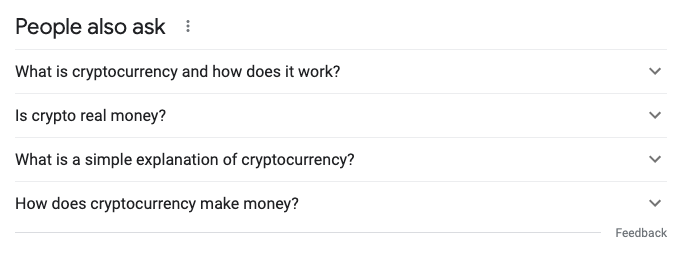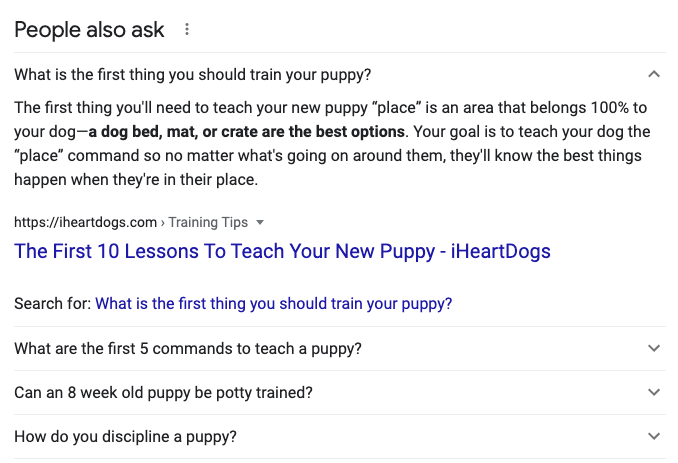Google overwhelmingly dominates the search engine market, maintaining over 92% of the market share as of June 2021. Let’s put that into perspective — an estimated 227 million Google searches occur every hour in the United States. Google’s title as the leading search engine doesn’t come as much a surprise, especially when we consider our browsing habits. Most people turn to a search engine, primarily Google, for answers to questions, research, and entertainment.
But as our habits change, Google constantly refines its algorithm, through human analysis and machine learning, to serve up better results. Google knows that users only typically skim through the first few organic results on the search engine result page (SERP). Thus, Google wants to ensure the top results will meet our expectations. As part of this process, Google introduced helpful features like “People Also Ask” to answer informational “how-to” search queries. As such, businesses must cater to audiences with unique content and search engine optimization (SEO) strategies to control these highly visible placements.
Premiere Creative is here to outline Google’s “People Also Ask” feature, allowing you to maximize “how-to” keywords in your user-centric SEO content strategy.
What is the “People Also Ask” Box?
Google launched the dynamic “People Also Ask” (PAA) SERP feature in April of 2015. These snippets sought to answer frequently searched questions as they relate to the original search term. After typing a query into the search bar, Google serves up related questions in a box titled “People Also Ask,” which typically appears after the top three organic results.
The box highlights a list of related search questions with a dropdown that reveals a snippet of information that directly answers the question.

For example, try typing in “What is cryptocurrency?” You will see a PAA box appear with these four questions:
- What is cryptocurrency and how does it work?
- Is crypto real money?
- What is a simple explanation of cryptocurrency?
- How does cryptocurrency make money?
When a user clicks on one of these PAA questions, the dropdown features an informative piece of content that answers the question, along with the article’s title and a URL to the article’s website. The content featured in this tab will appear as a graphic, a video, or web copy from a website.
As this is an opportunity for brands to attract new users organically, the “People Also Ask” (PAA) box is a coveted ranking slot. With so much competition for these sought-after spots, brands hoping to maximize the potential of PAA ranking must deploy an appropriate content strategy that targets these common questions.
What is “How-To” Content?
When users encounter an unfamiliar concept, they quickly turn to Google. Most of these search queries begin with phrases like “How to,” which then triggers the PAA box. Brands seeking to capitalize on this opportunity can offer their expertise and knowledge through articles, blogs, videos, graphics, and website content to improve organic rank and gain traffic to their website.
For example, imagine you just brought home a newborn puppy. Since you’re treading through unfamiliar waters, you type “How to train a puppy” into the search bar.

You will then see these questions in the “People Also Ask” box:
- What is the first thing you should train your puppy?
- What are the first 5 commands to teach a puppy?
- Can an 8 week old puppy be potty trained?
- How do you discipline a puppy?
Everyone from vets to doggy daycares and pet supply stores can create informational content targeting these topics to establish relevancy and command rank for these keywords. For example, a doggy daycare company may publish a long-form blog on “How to Train a 10-Week-Old-Puppy.” Not only does “how-to” content help improve quality rankings and capture organic traffic, but it is also a fantastic way to increase user experience through credibility and trust.
Understanding Search Intent & How Users Search for Information
While search engine algorithms do some of the heavy lifting in analyzing search intent, brands should also consider the reasoning behind search queries. Search intent describes the purpose for a search or the user’s end goals. There are four main types of search intent, including:
- Informational: searching for more information about a topic.
- Navigational: looking to navigate to a specific website.
- Transactional: looking to make a purchase at the moment of the search.
- Commercial: looking to research products/services before making a purchase.
When you understand the motive behind users’ search habits, you can adjust your content strategy to rank for these informational keywords. For example, if a user wants information about how to potty train their new puppy — but search results keep showing puppy pads for sale — Google failed at delivering answers. Instead, the user will benefit more from a helpful article, infographic, or video that explains different puppy potty training techniques with clear instructions on how to execute them.
Building a Content Strategy with Informational Keywords
Building a content strategy begins with setting goals. Ask yourself what you hope to accomplish by deploying this updated content strategy.
- Are you trying to capture more traffic on your website?
- Do you want to increase awareness of your brand?
- Do you want to establish credibility with users?
Do you want to increase your ranking on SERP for certain topics?
Once you outline your SEO goals, you can begin to understand and define your audience.
- How are they searching?
- Where are they searching for information?
- What kinds of content do they want to consume?
Understanding your audience helps promote a user-centric SEO strategy, meaning the overall goal is to provide value for the customer, not just sell your product and services.
Catering Content to User Search Habits
Next, come up with a list of relevant industry topics that target keywords users are already searching for. It is important to include a mix of broad terms and long-tail keywords that flow naturally within the content. Using the above example, a user might search for a more specific how-to question, such as “how to potty train a puppy in the winter.” The more detailed long-tail keyword has lower search volume but also lower competition. Brands can maximize their ranking by targeting more specific long-tail keywords with relevant and useful information.
Use the PAA Box to Boost Organic Ranking & Drive Website Traffic
When strategized properly, your organic ranking can soar with an informational keywords content strategy. If you want to develop a strong organic presence and user experience with content, Premiere Creative can help. We help brands achieve their SEO goals with meticulous keyword research, audience targeting, informational blogs, long-form content, and geo-targeted landing pages to improve your brand’s organic visibility and increase conversions. Contact us today at (973) 346-8100 to get started!

